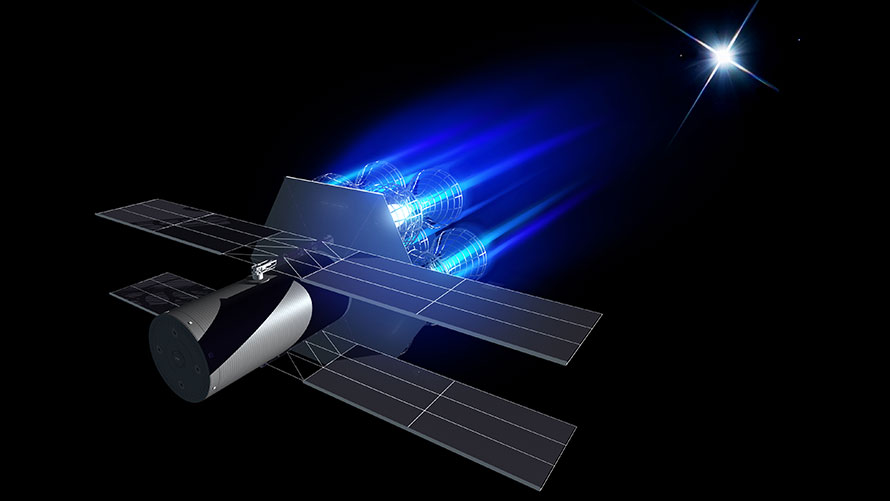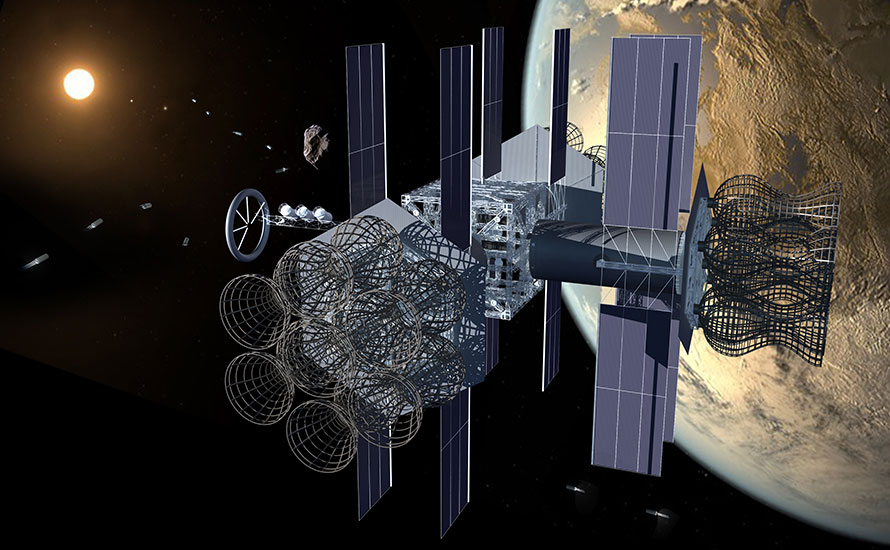- Roadmap Table of Contents
- Part 1: General Milestones
- Part 2: Utilization and Development of Cislunar Space
- Part 3: To the Moon
- Part 4: To Mars
- Part 5: Asteroid Mining and Orbital Space Settlements
- Part 6: Additional Expansion and Greater Sustainability of Human Civilization (this page)
MILESTONE 29. Terraforming and Para-Terraforming
Modification of other planets or moons to support human, animal and plant life in a manner similar to the Earth.

Image: Kevin Gill. Click image for larger version. Click resulting image for very large detailed image (and use scroll bars to scan).
DESCRIPTION
Terraforming (literally, “Earth-shaping”) of a planet, moon, or other body is the hypothetical process of deliberately modifying its atmosphere, volatile components, temperature, surface topography or ecology to be similar to the environment of Earth and to make it habitable for Earth life.
Three levels or types of terraforming are:
- Para-terraforming – very large scale pressurized habitats and agricultural zones exist on the surface without requiring substantial external atmospheric modifications. This assumes that the cosmic radiation flux present on a surface without a dense atmosphere can be dealt with in some way.
- Partial terraforming – adequately blocks cosmic radiation, allows some kinds of plants to grow on the surface and humans to walk there without pressure suits and without radiation protection, but with air-breathing equipment, and at an ambient pressure of about one half Earth sea level or more.
- Full terraforming – extensive modification of a world’s surface to provide an Earth-type atmosphere and aquasphere, allowing survival of humans, animals and plants without special protective equipment.
Terraforming of a cold, dry planet similar to Mars would include four main phases:
- Warming the planet so that water is not frozen.
- Importing enough nitrogen atmospheric mass to stop galactic radiation from reaching the surface.
- Importing enough water to provide wide areas of water surface, allowing significant humidity and rainfall.
- Creating enough oxygen in the atmosphere from in-situ resources.
An additional long-term step may be the creation of an artificial magnetosphere around the planet, to prevent the solar wind from stripping away the new atmosphere.
Mars is the most obvious example of a terraformable planet in our solar system, but different types of planets would require different kinds of terraforming operations and sequences. A planet with an atmosphere that is too dense to breathe could, with great effort and significant time, have the excess atmosphere removed, if the air mass was not too huge. If the planet is not too hot and has water, oxygen-producing algae may be able to be introduced early on to start oxygen production.
COMPONENTS (major types of terraforming modifications)
- Preventing cosmic radiation from reaching the surface.
- Adjusting the average planetary temperature.
- Adding atmospheric mass to allow water on the surface.
- Adjusting the amount of water surface and depth.
- Adjusting the oxygen-nitrogen amount and balance.
- Removing toxic substances in the atmosphere.
- Creating a biosphere on the planet’s surface.
- Creating areas of arable land.
BARRIERS (general)
- Opposition to terraforming by those who claim that “rocks have rights” which are considered more important than bringing life on to another world.
- Opposition by people who think large scale human projects are morally wrong or reduce the beauty of a planet.
- If it is decided by humankind that only totally sterile planets may be terraformed, then we will need a valid and publicly acceptable means of effectively demonstrating that a planet meets established criteria of sterility before terraforming efforts begin.
- The need to establish a set of criteria for whether to terraform planets which are known to harbor life of some kind.
BARRIERS (items lacking)
- Engineering and construction methods to cover large land areas with pressurized enclosures for paraterraforming efforts.
- A means of creating perfluorocarbon (super-greenhouse) gases on some planets from carbon and fluorine, including finding large sources of fluorine in Mars minerals.
- A means of creating (and keeping in position) giant, low mass parasols or mirrors used for thermal control at some planets.
- A means of moving very large masses of volatiles such as frozen nitrogen, CO2 or water ice to planets where the volatiles are needed with very large space tugs.
- A fusion space drive to power space tugs to move the huge masses of volatiles.
- Replicator systems to build a large fleet with thousands of very large fusion powered space tugs and units for mining volatiles.
- Smart software to safely operate this fleet and to prevent malevolent forces from taking control of them to cause mass destruction.
- Software to simulate the climatological effects of the proposed terraforming efforts.
COMPLETION
(A) The partial terraforming milestone (which covers several different situations) can be considered achieved when the climate and atmosphere of at least a substantial portion of one planet has been changed enough to achieve one or more of the following: (1) prevent harmful levels of radiation from reaching the surface, (2) cause water to flow on a substantial portion of the surface of a previously frozen planet, (3) enable rain to fall on the surface of a previously dry planet, (4) enable some kinds of plant life to grow on the surface or in the waters of a previously sterile planet.
(B) The full terraforming milestone will be achieved when humans, plants and animals can directly breath and use the air and work on the surface of a previously oxygen-free planet without pressure suits, oxygen supplies or radiation protection.
MILESTONE 30. Development of Interstellar Travel and Settlement
Human travel to other solar systems and establishment of settlements in space and/or extrasolar planets in these solar systems.

Interstellar generation ship doing a deceleration burn with its 7 fusion engines while approaching another solar system. The body of the vessel is a cylinder 3 kilometers in diameter. Attached are large heat radiators. Image: [email protected]
DESCRIPTION
Interstellar travel requires travel over distances that are hard for humans to visualize. The stars are very far away, the nearest being more than four light years distant, and totally unreachable by any propulsion system currently in existence. However, the expansion of humanity into the universe to live among the stars remains a central dream for many. Interstellar travel would allow human civilization and Earth’s biosphere to spread beyond our solar system, thus improving the probability of long-term species survival. It can be accomplished without using “magic physics,” and this Roadmap does not consider any such “magical” methods.
It is now known that planets are commonplace and some near-Earth-like planets are expected to be found somewhere among the nearer stars. Planets, however, are not needed for human habitation of another solar system because asteroids are likely to be available to support populations in orbital settlements in numbers much larger than what planetary surfaces could support. Thus, detection of habitable or terraformable planets in a star system in advance of a voyage is not required, but may be desirable, whereas the presence of either terrestrial-type planets or asteroids as a material source is required. It is possible that on arrival in a target planetary system, new in-space settlements, along with industrial infrastructure, would be constructed using local in-space materials, before any settlement is attempted on a planet.
In the absence of an Earth-like planet, the vessels will need to carry with them the equipment to build pressurized surface settlements and/or mine asteroids and build rotating space settlements. As the population and in-space industrial base is built up, the human settlers may eventually terraform any suitable planets. In addition to crew and passengers, interstellar vessels may carry frozen embryos or other forms of genetic data which can be reconverted to live organisms for genetic diversity.
Successful interstellar voyages by humans would mark a new phase in the existence of humanity, where humans would be living in more than one solar system.

Three interstellar generation ships arrive in another solar system and dock at a cubicle structure with a manufacturing facility (all made from parts brought with them) which in turn constructs torus space settlements out of local asteroid material. Image: [email protected]
COMPONENTS (1. Some types of interstellar missions)
- Generation ship: A very large rotating space settlement with its own propulsion and energy source which can maintain an artificial biosphere for hundreds of years. Passengers and crew would remain “awake” during the entire trip. The people arriving at the destination would be the descendants of the original voyagers.
- Single generation ship: A ship where the occupants have extended life spans such that most of them are expected to live long enough to reach the destination.
- Hibernation ship: The occupants would be in long term hibernation or cryogenic suspension during the trip, while some may remain awake, or be alternately awakened, to protect the ship and occupants.
- Seed ship: A ship controlled by AI systems, containing frozen embryos or DNA data which is then used at destination to artificially gestate and rear humans. No adult humans are on board. Automated systems would need to produce habitats for the humans to live in from asteroidal or planetary surface resources.
- Interstellar probe: A scientific craft containing no crew or genetic material but able to serve as a technological step toward crewed missions. If a laser and light sail system is used, this vehicle could have a relatively small mass. Ideas also exist for much smaller probes that would be sent in swarms, in succession, and to multiple star systems, by the same laser system. If they are practical, these “star wisps” (named by Dr. Robert Forward), would become invaluable interstellar scouting agents for the human race. The main lower size limitation for such probes is having enough mass and energy to successfully transmit data back to Earth.
COMPONENTS (2. Types of human settlement operations)
Once a human settlement ship has reached another solar system, a variety of operations could begin in order to expand the human population and provide multiple places for them to live. There can be at least six major types of such human operations in a given solar system:
- Mining, transfer and use of space resources in the system.
- Building rotating space settlements.
- Establishment and growth of pressurized surface settlements.
- Para-terraforming – creation of widespread pressurized environments on planetary surfaces.
- Terraforming planets to allow human settlements and Earth plant and animal life to exist on them outside of pressurized environments.
- Construction of interstellar settlement vessels.
BARRIERS
- Lack of propulsion methods (such as the equivalent of fusion or antimatter drives) needed to reach speeds of at least 1 percent of the speed of light, or about 3000 kilometers per second.
- Lack of energy sources such as fusion to support a ship for a century or more.
- Lack of a means of protecting the ship from collision with interstellar debris and to protect the passengers from particulate radiation caused by the ship’s high velocity.
- Lack of methods to sustain a generation ship’s closed ecology for many decades.
- Lack of methods to sustain a generation ship’s motivation and technological expertise for many decades.
- Lack of ability to build new in-space settlements from local asteroidal resources.
- Lack of consensus that sterility of a planet is necessary for practical or ethical reasons and lack of a means of effectively proving that a planet is sterile before it can be used for settlement.
- Lack of a means of terraforming chosen planet(s).
- Lack of multi-decade hibernation and/or cryogenic suspension methods that are reliable and safe.
- Lack of sufficient economic resources and/or political will to undertake the necessary research and construction.
- Belief that interstellar voyages are impossible.
- Political opposition to expansion of human civilization across the galaxy.
COMPLETION
This milestone can be considered achieved when a human settlement is established and growing in at least one solar system besides our own.
MILESTONE 31. Survival of the Human Species Via Space Settlement
Through the general expansion of space settlement and the development of specific, isolated settlements designed to survive, space settlement increases the likelihood that the human species will survive in the long term.
 Image: Richard Bizley, bizelyart.com
Image: Richard Bizley, bizelyart.com
DESCRIPTION
One of the major goals of space settlement is to ensure the survival of the human species. Indeed, if humanity does not survive, then the value of all of its efforts is lost.
Space settlements may ensure the survival of humanity from two categories of existential risks—those caused naturally and those caused by advanced human technology. Commonly recognized natural risks include: asteroid impacts, supervolcanoes, gamma ray bursts, etc. Technological causes include biotech, self-replicating chemicals, nanotechnology, and accelerating AI. Certain other human activities could severely harm humanity while not being a complete threat to human existence (e.g. nuclear war). According to the Future of Humanity Institute, human extinction is more likely to result from human technological causes rather than natural causes.
There are two categories of space settlement which could result in humanity surviving existential risks.
(1) The general, longer-term growth and redundancy of space settlement becomes so large that settlements (or a network of settlements) could adjust and survive despite being cut off from Earth even without taking specific efforts to be prepared for existential risks. This is a sort of self-sufficiency which would be good for risks in the longer term but not the nearer-term.
(2) Alternately, in the nearer-term, settlements specifically designed for survival could focus their development upon providing the essential needs of the settlement by using local resources (without engaging in trade), and seeking isolation from risks of extinction. They would need to reproduce from local resources all of the equipment necessary to produce essential needs.
COMPONENTS of survival settlements
- Identification of the essential needs for survival and the reproduction of equipment necessary to provide those needs.
- Development and demonstration of these systems in analogue bases and near-term space settlements.
- “Stress-testing” of these settlements by isolation (i.e. not supplying them) in order to prove that they could survive indefinitely if necessary.
- Provision of a means of relocation for some of the population of the settlement to another survivable location.
BARRIERS
- Lack of understanding of the minimum number of humans needed to maintain a human civilization from a genetic, technological, and sociological point of view.
- Lack of identifiable economic drivers to create survival settlements.
- Long time frame to achieve sufficient redundancy in space settlements.
COMPLETION
This milestone can be considered achieved when careful analysis concludes that at least some settlements would likely survive recognized existential risks emanating from Earth or elsewhere.






